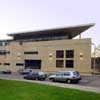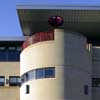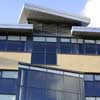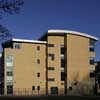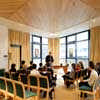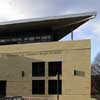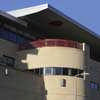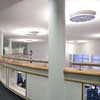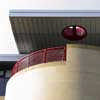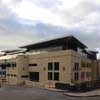St Thomas Aquins School Photos, Edinburgh Education Building, Architect, Project, Images
St Thomas Aquin’s School Edinburgh
Modern Edinburgh School Building, Scotland, UK
St Thomas Aquin’s School
City centre school building
St Thomas of Aquin’s High School, Edinburgh
Date of completion: Oct 2002
Project Architect: Don Mackenzie, for Property Services, the City of Edinburgh Council
Address: Chalmers Street, south-central Edinburgh
Photographer: Antonia Reeve Photography, Edinburgh
INTRODUCTION
The new 750 pupil St Thomas of Aquin’s High School was opened in August 2002. It was built on the site of the old school following closure of the building in 1998 as it had become unsuitable to meet safety, security and curriculum requirements. It could also not be converted to support the integration of pupils with special needs.
The school community expressed a strong desire to remain on the existing city-centre site rather than go to a new ‘greenfield’ location, due to strong historical links with the area and the adjacent convent.
DESIGN PRECEDENT
The brief was developed with the client to include innovative design principles pioneered by the design team on previous schools, in particular, Leith Academy and St Margaret’s Academy in Livingston.
These previous designs drew international attention via the O.E.C.D.S ‘Programme for Educational Buildings’ conferences, especially in relation to the subjects of ‘Life-long Learning’, ‘Community Use’ and ‘Design for Change’.
Further input had also been taken from a study tour of buildings including, Farnborough College, Stockley Business Park and the Hampshire schools.
A link has also been formed with the RIAS ‘Schools Design Forum’.
As this site is unique in requiring an urban design solution, design resolutions which maximise the use of internal and external space were also researched.
OBJECTIVES
The main design aims include the following:
Asset Creation (as detailed later)
Quality of design and build – approval of Planners, Royal Fine Arts Society, Historic Scotland
Spaces ‘suited’ together to encourage inter-departmental working
Loose-fit principles to support both short and long term change
Expansion strategy – demographic change
Appropriate site development
Sustainability – as ‘green’ as possible within constraints : enhanced air volumes and classroom spaces, solar shading, ‘natural systems’
Welcoming, non institutional environment
To support life-long learning and adult use
‘Special needs’ integration
A special place
THE DESIGN
Asset Creation: The design of St Thomas of Aquin’s High School has been approached as a synthesis of national and international experience to provide the client with a building purpose-designed to embody the individual character and spirit of the school, yet which is also flexible and responsive to future changes in user needs.
For example, the design of the building services, the loose-fit furnishing strategy and the clear span, modular structure and glazing would allow radical change in use. This could even include extensive removal of partitions to create very large open plan areas for IT based learning, not founded on classroom groups, following models currently being pioneered in the United States, should such a degree of curriculum shift arise.
The school is designed for full I.T flexibility to support a laptop computer for every pupil if required.
The principles previously pioneered by this design team at, for example, Leith Academy and St Margaret’s Academy, Livingston, have been incorporated and developed in the context of an urban site.
The building is therefore equipped to help, rather than hinder, the process of change to meet future needs, thus ensuring that it remains a long-term asset
Even during the process of design and construction the clients needs change. The flexibility strategies have already proved their value in ensuring the building can respond, providing optimal support to changing curriculum and technology.
Design Response to Site
Main Entrance – The majority of pupils, staff and the public arrive from the direction of Lauriston Place. In response to this and the sloping nature of Chalmers Street, a main entrance location is naturally generated at the north-east corner of the site, at a level one storey above the general site level.
The Street Frontage – The requirement for a clear-span, flexible building comprising teaching accommodation, with maximum natural light as well as predominantly natural ventilation and a central circulation spine gives rise to a building depth which approximately matches that of the previous buildings fronting Chalmers Street.
It was also necessary to create a secure, enclosed site, to comply with the Cullen report.
There was a need to respond to the planning constraints relating to preservation of streetscape, which reflect the urban infill nature of the development. The future expansion site to the south allows eventual restoration of an urban frontage.
All of the above advocated provision of a four storey band of accommodation fronting on to Chalmers Street, of approximately the volume of the existing buildings. This accommodation is generally set back from the pavement to maintain the previously existing lines of frontage and basements.
Development within the Site – Whilst the frontage respects the existing character and scale of Chalmers Street, a second volume of teaching accommodation is angled to the main block, intersecting with it at the focal point of the main entrance.
This angle creates a spatial dynamic within the building and generates two enclosed courtyards within the site, predominantly hard landscaped, to maximise useable space, at a premium on an urban site, but softened with some planting.
The angled wing also picks up on the many non orthogonal angles seen in the surrounding street/building forms and allows the façade to relate in a more sympathetic manner than had it been in parallel confrontation to the neighbouring RIE Eye Pavilion. The angle also recognises the presence of the Convent Garden, allowing it to be seen from the building without directly facing on to it at a right-angle.
The ‘moat’ along the remainder of the street frontage, a reflection of the recessed basement garden format of the former terraced houses, allows the façade to ‘open up’ into a more delicate stone lattice. This is enlivened with a proportion of acid-etched glass which serves to diffuse direct light more deeply into the classrooms (complementing other ‘green’ features, such as the increased room heights and air volumes, increased window heights, neutral tinted solar glass and artificial lighting which dims automatically in response to available daylight). Also expressed to the Chalmers Street frontage are the pupils’ informal social spaces, behind the diagonally projecting bay windows.
Ramped access into this basement area provides secure off-street cycle parking to encourage use of the local safe cycle-ways in the Meadows, as well as offering community access out of normal school hours to the sports club/dance/drama/music facilities whilst he remainder of the school is locked off.
Assembly/Social/’Street Café’ space – The identity of the building is expressed by the sequence of entry, focussing on a welcoming arrival, necessary security, moving through the main entrance at the upper level of the main assembly ‘internal courtyard’ and social space. Views downwards across this space are also directed, via the full height glazed wall, on to the external courtyard beyond.
This space appears to be working well as intended, supporting the wide variety of activities intended of a civic space within the school – functions/performances/seminars and presentation/street café/market place/meeting place. For this ‘commons’ space to be lively, it was essential for it to be central and on a natural circulation route.
For more formal events the space is capable of being enclosed with circulation routed around and over. The brief emphasised no wish for a formal ‘proscenium’ provision as the new school has a purpose-built drama studio and also has the use of a nearby hall when required.
The stone façade to Chalmers Street with its strongly expressed solids and voids provides a defensive element yet clearly marks the entrance where the building meets the street and so is also, paradoxically, a welcoming feature.
Other key spaces grouped vertically behind the wall and about the main staircase include a simple chapel/oratory space (the spiritual core of the building) and the central IT/learning resource/library suite which is designed to be flexible to support ‘open learning’. Also grouped around the core are the ‘interface’ spaces where parental involvement is encouraged, ie. the learning support and special needs suite, admin, meeting and interview rooms. This provides a further security feature preventing public access deeper into the school.
SUMMARY
The provision of a new secondary school building for St Thomas of Aquin’s High School in an urban context has proved both challenging and rewarding.
By incorporating a number of ‘loose-fit’ strategies the building will be a long term asset, a facility which will help rather than hinder the process of change.
The major strategic objectives having been achieved, the over-arching requirement was to engage with the school community in close dialogue to ensure that the resulting design should be a unique and special place for the school to return to on its historic site.
Our focus was not only to provide a finely-tuned educational resource but especially to create a characterful, purposeful and stimulating environment to inspire learning.
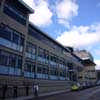
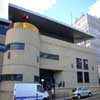
building: photos © Adrian Welch Sep 2006 with lumix camera
Cost: £14m
St Thomas of Aquin’s High School is the first of Edinburgh‘s £133m Smart School Initiative programme completed
The building won the ‘SCALA Civic Building of the Year Award’, and a ‘Designshare Award’.
The building was also designed in association with the O.E.C.D. Programme for Educational Buildings, Paris.
It now also features in a number of architectural design guideline documents.
St Margaret’s School Edinburgh
Edinburgh University Buildings
Comments / photos for the St Thomas Aquins School Edinburgh Architecture page welcome
